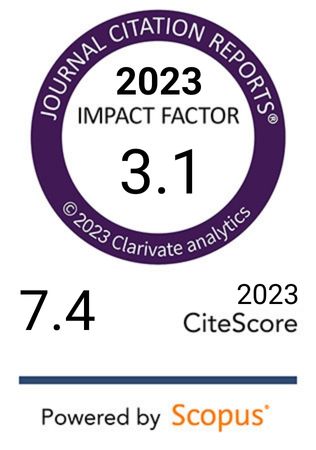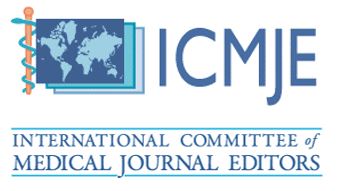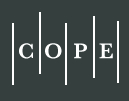Chronic otitis media with effusion in children with adenoidal hypertrophy: Development of a diagnostic prediction model
DOI:
https://doi.org/10.17305/bb.2025.12825Keywords:
Adenoid hypertrophy, children, chronic otitis media with effusion, nomogram, risk factorAbstract
Chronic otitis media with effusion (COME) is a prevalent condition that poses significant risks to the growth and development of children with adenoidal hypertrophy (AH). This study investigates the risk factors associated with COME in children diagnosed with AH and establishes a clinical prediction nomogram to enhance diagnostic accuracy. The study included 311 children with AH, diagnosed through lateral nasopharyngeal radiographs, from the Department of Otorhinolaryngology Head and Neck Surgery at the First Affiliated Hospital of Anhui Medical University. Risk factors were identified using the least absolute shrinkage and selection operator (LASSO), while Firth's penalized logistic regression analysis was employed to further refine the variables and develop a predictive model. The model's performance was assessed using the C-index, calibration curve, and decision curve analysis, with internal validation conducted through bootstrapping. The resulting predictive nomogram included four key risk factors: young age, vitamin D3 deficiency, degree of AH, and tympanometry results. The model exhibited strong predictive capabilities, achieving a C-index of 0.945 (95% confidence interval: 0.941, 0.949). Bootstrapping validation confirmed a high C-index of 0.934. The calibration curve demonstrated good alignment, while the decision curve indicated a net benefit across thresholds of 10%–90%. This nomogram—incorporating tympanometry, AH degree, serum vitamin D3 levels, and age—serves as a valuable tool for clinicians and families in assessing the risk of COME in children with AH.
Citations
Downloads
References
Editorial Board of Chinese Journal of Otorhinolaryngology H, Neck S, Subspecialty Group Of P. [Guideline for the diagnosis and treatment of otitis media with effusion in children (2021)][J]. Zhonghua Er Bi Yan Hou Tou Jing Wai Ke Za Zhi, 2021, 56(6): 556-567.
Baggi E, Semino M, Bianchini S, Fattizzo M, Rosazza C, Esposito S, et al. Middle ear problems in children hospitalised because of lower respiratory tract infections: a comparison between two cohorts in Burundi and Italy[J]. Int J Pediatr Otorhinolaryngol, 2013, 77(12): 1984-6. https://doi.org/10.1016/j.ijporl.2013.09.018
Parmar S, Davessar JL, Singh G, Arora N, Kansal L, Singh J. Prevalence of Otitis Media with Effusion in Children with Hearing Loss[J]. Indian J Otolaryngol Head Neck Surg, 2019, 71(Suppl 2): 1276-1281. https://doi.org/10.1007/s12070-018-1310-y
Biagio L, Swanepoel DW, Laurent C, Lundberg T. Paediatric otitis media at a primary healthcare clinic in South Africa[J]. S Afr Med J, 2014, 104(6): 431-5. https://doi.org/10.7196/SAMJ.7534
Tos M. Epidemiology and natural history of secretory otitis[J]. Am J Otol, 1984, 5(6): 459-62.
Vanneste P, Page C. Otitis media with effusion in children: Pathophysiology, diagnosis, and treatment. A review[J]. J Otol, 2019, 14(2): 33-39. https://doi.org/10.1016/j.joto.2019.01.005
Li S, Huang Y, Chen X, Wang W, Zhang Q, Zhang Q, et al. [Effect of otitis media with effusion on vestibular function in children: a pilot study][J]. Lin Chuang Er Bi Yan Hou Tou Jing Wai Ke Za Zhi, 2020, 34(3): 202-206.
Aniansson G, Alm B, Andersson B, Hakansson A, Larsson P, Nylen O, et al. A prospective cohort study on breast-feeding and otitis media in Swedish infants[J]. Pediatr Infect Dis J, 1994, 13(3): 183-8. https://doi.org/10.1097/00006454-199403000-00003
Songu M, Islek A, Imre A, Aslan H, Aladag I, Pinar E, et al. Risk factors for otitis media with effusion in children with adenoid hypertrophy[J]. Acta Otorhinolaryngol Ital, 2020, 40(2): 133-137. https://doi.org/10.14639/0392-100X-2456
Rosenfeld RM, Shin JJ, Schwartz SR, Coggins R, Gagnon L, Hackell JM, et al. Clinical Practice Guideline: Otitis Media with Effusion (Update)[J]. Otolaryngol Head Neck Surg, 2016, 154(1 Suppl): S1-S41. https://doi.org/10.1177/0194599815623467
Aslıer M, Aslıer NGY, Ercan İ, Keskin S. Clustering upper airway physicals, otitis media with effusion and auditory functions in children[J]. Auris Nasus Larynx, 2022, 49(2): 195-201. https://doi.org/10.1016/j.anl.2021.07.001
Li P, Li T, Yu L, Chen A, Wu Y, Wan Y, et al. Predictive Value of Adenoid-Nasopharyngeal Ratio in the Diagnosis of Secretory Otitis Media[J]. Ear Nose Throat J, 2025, 104(9): Np618-np625. https://doi.org/10.1177/01455613221144496
Austin DF. Adenoidectomy for secretory otitis media[J]. Arch Otolaryngol Head Neck Surg, 1989, 115(8): 936-9. https://doi.org/10.1001/archotol.1989.01860320046016
Gleeson MJ. SCOTT-BROWN'S OTORHINOLARYNGOLOGY, HEAD AND NECK SURGERY, 7TH EDITION[J]. Proceedings of the Prehistoric Society, 2008, 33(1-4): 42-468. https://doi.org/10.1201/b15118
Brennan-Jones CG, Whitehouse AJ, Park J, Hegarty M, Jacques A, Eikelboom RH, et al. Prevalence and risk factors for parent-reported recurrent otitis media during early childhood in the Western Australian Pregnancy Cohort (Raine) Study[J]. J Paediatr Child Health, 2015, 51(4): 403-9. https://doi.org/10.1111/jpc.12741
Watters GW, Jones JE, Freeland AP. The predictive value of tympanometry in the diagnosis of middle ear effusion[J]. Clin Otolaryngol Allied Sci, 1997, 22(4): 343-5. https://doi.org/10.1046/j.1365-2273.1997.00023.x
Xian ZX, Li L, Liang ZJ. Comparison of the diagnostic value of nasopharynx lateral film and electronic nasopharyngoscope in children with adenoid hypertrophy[J]. Journal of Clinical Otorhinolaryngology Head and Neck Surgery, 2007; 996-998. DOI: 10.3969/j.issn.1001-1781.2007.21.013.
Pan SL, Zhou F, Zhou YH, Zhong PD. Application of lateral nasopharynx film in diagnosis of adenoid hypertrophy in children in township hospitals[J]. Smart Healthcare, 2023, 9: 17-20. DOI: 10.19335/j.cnki.2096-1219.2023.08.005.
Fujioka M, Young LW, Girdany BR. Radiographic evaluation of adenoidal size in children: adenoidal-nasopharyngeal ratio[J]. AJR Am J Roentgenol, 1979, 133(3): 401-4. https://doi.org/10.2214/ajr.133.3.401
Alvarez D, Gutierrez-Tobal GC, Del Campo F, Hornero R. Positive airway pressure and electrical stimulation methods for obstructive sleep apnea treatment: a patent review (2005-2014)[J]. Expert Opin Ther Pat, 2015, 25(9): 971-89. https://doi.org/10.1517/13543776.2015.1054094
Sharifkashani S, Dabirmoghaddam P, Kheirkhah M, Hosseinzadehnik R. A new clinical scoring system for adenoid hypertrophy in children[J]. Iran J Otorhinolaryngol, 2015, 27(78): 55-61.
Adedeji TO, Amusa YB, Aremu AA. Correlation between adenoidal nasopharyngeal ratio and symptoms of enlarged adenoids in children with adenoidal hypertrophy[J]. Afr J Paediatr Surg, 2016, 13(1): 14-9. https://doi.org/10.4103/0189-6725.181701
Chen WB, Wang YC. Diagnosticology, 5th ed. Beijing: People's Medical Publishing House, 2001, pp. 549-562.
Masna K, Zwierz A, Domagalski K, Burduk P. The Impact of the Thermal Seasons on Adenoid Size, Its Mucus Coverage and Otitis Media with Effusion: A Cohort Study[J]. J Clin Med, 2021, 10(23): 5603. https://doi.org/10.3390/jcm10235603
Group WHOMGRS. WHO Child Growth Standards based on length/height, weight and age[J]. Acta Paediatr Suppl, 2006, 450: 76-85. https://doi.org/10.1111/j.1651-2227.2006.tb02378.x
De Onis M, Onyango AW, Borghi E, Siyam A, Nishida C, Siekmann J. Development of a WHO growth reference for school-aged children and adolescents[J]. Bull World Health Organ, 2007, 85(9): 660-7. https://doi.org/10.2471/BLT.07.043497
Holick MF, Chen TC. Vitamin D deficiency: a worldwide problem with health consequences[J]. Am J Clin Nutr, 2008, 87(4): 1080S-6S. https://doi.org/10.1093/ajcn/87.4.1080S
Harrell FE. Regression modeling strategies: with applications to linear models, logistic regression, and survival analysis. Berlin: Springer, 2010.
Sauerbrei W, Royston P, Binder H. Selection of important variables and determination of functional form for continuous predictors in multivariable model building[J]. Stat Med, 2007, 26(30): 5512-28. https://doi.org/10.1002/sim.3148
Friedman J, Hastie T, Tibshirani R. Regularization Paths for Generalized Linear Models via Coordinate Descent[J]. J Stat Softw, 2010, 33(1): 1-22. https://doi.org/10.18637/jss.v033.i01
Heinze G, Schemper M. A solution to the problem of separation in logistic regression[J]. Stat Med, 2002, 21(16): 2409-2419. https://doi.org/10.1002/sim.1047
Niedzielski A, Chmielik LP, Kasprzyk A, Stankiewicz T, Mielnik-Niedzielska G. Health-Related Quality of Life Assessed in Children with Adenoid Hypertrophy[J]. Int J Environ Res Public Health, 2021, 18(17): 8935. https://doi.org/10.3390/ijerph18178935
Ma R, Tian L, Ren DD. Clinical diagnosis and audiological characteristics of otitis media with effusion in elder children combined with adenoid hypertrophy[J]. Chinese Journal of Ophthalmology and Otorhinolaryngology, 2013, 13: 159-162. DOI: 10.14166/j.issn.1671-2420.2013.03.015.
Wu S, Zhao W, Mai QW, Gao MQ, Lin QW, Zheng YG, et al. Comparison of the clinical value and the differential diagnostic of otitis media with effusion between 226 Hz, 1000 Hz acoustic immittance and wideband immittance[J]. Chinese Journal of Ophthalmology and Otorhinolaryngology, 2019, 26: 302-305. DOI: 10.16066/j.1672-7002.2019.06.005.
Hidaka H, Ito M, Ikeda R, Kamide Y, Kuroki H, Nakano A, et al. Clinical practice guidelines for the diagnosis and management of otitis media with effusion (OME) in children in Japan - 2022 update[J]. Auris Nasus Larynx, 2023, 50(5): 655-699. https://doi.org/10.1016/j.anl.2022.12.004
Blanc F, Ayache D, Calmels MN, Deguine O, Francois M, Leboulanger N, et al. Management of otitis media with effusion in children. Societe francaise d'ORL et de chirurgie cervico-faciale clinical practice guidelines[J]. Eur Ann Otorhinolaryngol Head Neck Dis, 2018, 135(4): 269-273. https://doi.org/10.1016/j.anorl.2018.04.008
Ren DD, Wang WQ. Assessment of middle ear effusion and audiological characteristics in young children with adenoid hypertrophy[J]. Chin Med J (Engl), 2012, 125(7): 1276-81.
Veivers D, Williams GM, Toelle BG, Waterman AMC, Guo Y, Denison L, et al. The Indoor Environment and Otitis Media among Australian Children: A National Cross-Sectional Study[J]. Int J Environ Res Public Health, 2022, 19(3): 1551. https://doi.org/10.3390/ijerph19031551
Ricci A, Avanzini MA, Scaramuzza C, Castellazzi AM, Marconi M, Marseglia GL. Toll-like receptor 2-positive and Toll-like receptor 4-positive cells in adenoids of children exposed to passive smoking[J]. J Allergy Clin Immunol, 2005, 115(3): 631-2. https://doi.org/10.1016/j.jaci.2004.11.044
Wang M, Jing H, Guo H, Li X, Sun J. [Evaluation of Eustachian tube function in children with adenoid hypertrophy by nasopharyngeal digital photography and ETDQ-7 scores][J]. Lin Chuang Er Bi Yan Hou Tou Jing Wai Ke Za Zhi, 2022, 36(1): 24-26.
Maw AR, Jeans WD, Fernando DC. Inter-observer variability in the clinical and radiological assessment of adenoid size, and the correlation with adenoid volume[J]. Clin Otolaryngol Allied Sci, 1981, 6(5): 317-22. https://doi.org/10.1111/j.1365-2273.1981.tb01805.x
Marchisio P, Consonni D, Baggi E, Zampiero A, Bianchini S, Terranova L, et al. Vitamin D supplementation reduces the risk of acute otitis media in otitis-prone children[J]. Pediatr Infect Dis J, 2013, 32(10): 1055-60. https://doi.org/10.1097/INF.0b013e31829be0b0
Walker RE, Bartley J, Camargo CA Jr, Flint D, Thompson JMD, Mitchell EA. Higher serum 25(OH)D concentration is associated with lower risk of chronic otitis media with effusion: a case-control study[J]. Acta Paediatr, 2017, 106(9): 1487-1492. https://doi.org/10.1111/apa.13908
Akcan FA, Dundar Y, Akcan HB, Uluat A, Cebeci D, Unlu I. Evaluation of nasal mucociliary clearance time in patients with Vitamin-D deficiency[J]. Eur Arch Otorhinolaryngol, 2019, 276(4): 1075-1080. https://doi.org/10.1007/s00405-019-05286-y
Walker RE, Bartley J, Camargo CA Jr, Mitchell EA. Vitamin D and Otitis Media[J]. Curr Allergy Asthma Rep, 2019, 19(7): 33. https://doi.org/10.1007/s11882-019-0866-2
Caye-Thomasen P, Tos M. Histopathologic differences due to bacterial species in acute otitis media[J]. Int J Pediatr Otorhinolaryngol, 2002, 63(2): 99-110. https://doi.org/10.1016/S0165-5876(01)00641-3
Ooi JH, Li Y, Rogers CJ, Cantorna MT. Vitamin D regulates the gut microbiome and protects mice from dextran sodium sulfate-induced colitis[J]. J Nutr, 2013, 143(10): 1679-86. https://doi.org/10.3945/jn.113.180794
Felgentreff K, Beisswenger C, Griese M, Gulder T, Bringmann G, Bals R. The antimicrobial peptide cathelicidin interacts with airway mucus[J]. Peptides, 2006, 27(12): 3100-6. https://doi.org/10.1016/j.peptides.2006.07.018
Li DP, Huang H, He M, et al. Recent progress in diagnosis and treatment of secretory otitis media[J]. Chinese Journal of Otology, 2017, 15(01): 105-109. DOI: 10.3969/j.issn.1672-2922.2017.01.019.
Sadeghi K, Wessner B, Laggner U, Ploder M, Tamandl D, Friedl J, et al. Vitamin D3 down-regulates monocyte TLR expression and triggers hyporesponsiveness to pathogen-associated molecular patterns[J]. Eur J Immunol, 2010, 36(2): 361-370. https://doi.org/10.1002/eji.200425995
Li Y, Zhao SQ. Advances in Clinical Research on Otitis Media with Effusion and Allergic Rhinitis in Children[J]. Chinese Journal of Otology, 2016, 14(2): 295-298. DOI: 10.3969/j.issn.1672-2922.2016.02.034.
Aryan Z, Rezaei N, Camargo CA Jr. Vitamin D status, aeroallergen sensitization, and allergic rhinitis: A systematic review and meta-analysis[J]. Int Rev Immunol, 2017, 36(1): 41-53. https://doi.org/10.1080/08830185.2016.1272600
Khoo AL, Joosten I, Michels M, Woestenenk R, Preijers F, He XH, et al. 1,25-Dihydroxyvitamin D3 inhibits proliferation but not the suppressive function of regulatory T cells in the absence of antigen-presenting cells[J]. Immunology, 2011, 134(4): 459-468. https://doi.org/10.1111/j.1365-2567.2011.03507.x
Moore KW, De Waal Malefyt R, Coffman RL, O'garra A. Interleukin-10 and the interleukin-10 receptor[J]. Annu Rev Immunol, 2001, 19: 683-765. https://doi.org/10.1146/annurev.immunol.19.1.683
Mangin M, Sinha R, Fincher K. Inflammation and vitamin D: the infection connection[J]. Inflamm Res, 2014, 63(10): 803-19. https://doi.org/10.1007/s00011-014-0755-z
Waldron JL, Ashby HL, Cornes MP, Bechervaise J, Razavi C, Thomas OL, et al. Vitamin D: a negative acute phase reactant[J]. J Clin Pathol, 2013, 66(7): 620-2. https://doi.org/10.1136/jclinpath-2012-201301
Custodio G, Schwarz P, Crispim D, Moraes RB, Czepielewski M, Leitao CB, et al. Association between vitamin D levels and inflammatory activity in brain death: A prospective study[J]. Transpl Immunol, 2018, 48: 65-69. https://doi.org/10.1016/j.trim.2018.02.014
Giustina A, Lazaretti-Castro M, Martineau AR, Mason RS, Rosen CJ, Schoenmakers I. A view on vitamin D: a pleiotropic factor?[J]. Nat Rev Endocrinol, 2024, 20(4): 202-208. https://doi.org/10.1038/s41574-023-00942-0
Norhafizah S, Salina H, Goh BS. Prevalence of allergic rhinitis in children with otitis media with effusion[J]. Eur Ann Allergy Clin Immunol, 2020, 52(3): 121-130. https://doi.org/10.23822/EurAnnACI.1764-1489.119
Caylan R, Bektas D, Atalay C, Korkmaz O. Prevalence and risk factors of otitis media with effusion in Trabzon, a city in northeastern Turkey, with an emphasis on the recommendation of OME screening[J]. Eur Arch Otorhinolaryngol, 2006, 263(5): 404-8. https://doi.org/10.1007/s00405-005-1023-1
Luo Y, He P, Wen X, Gong R, Hu X, Zheng X. Otitis Media and Its Association With Hearing Loss in Chinese Adults: A Population Based Study of 4 Provinces in China[J]. Front Public Health, 2022, 10: 852556. https://doi.org/10.3389/fpubh.2022.852556
Bergroth E, Remes S, Pekkanen J, Kauppila T, Buchele G, Keski-Nisula L. Respiratory tract illnesses during the first year of life: effect of dog and cat contacts[J]. Pediatrics, 2012, 130(2): 211-20. https://doi.org/10.1542/peds.2011-2825
Da Costa JL, Navarro A, Neves JB, Martin M. Household wood and charcoal smoke increases risk of otitis media in childhood in Maputo[J]. Int J Epidemiol, 2004, 33(3): 573-8. https://doi.org/10.1093/ije/dyh071
Meng X, Wang Y, Han C, Gu X, Hang C, Guo J, et al. Clinical manifestations and outcomes of otitis media with effusion in adult patients following Omicron infection in China[J]. Biomol Biomed, 2024, 24(4): 1028-1034. https://doi.org/10.17305/bb.2024.10239
Keefe DH, Sanford CA, Ellison JC, Fitzpatrick DF, Gorga MP. Wideband aural acoustic absorbance predicts conductive hearing loss in children[J]. Int J Audiol, 2015, 51(12): 880-891. https://doi.org/10.3109/14992027.2012.721936
Ellison JC, Gorga M, Cohn E, Fitzpatrick D, Sanford CA, Keefe DH. Wideband acoustic transfer functions predict middle-ear effusion[J]. Laryngoscope, 2012, 122(4): 887-94. https://doi.org/10.1002/lary.23182
Hunter LL, Feeney MP, Miller JaL, Jeng PS, Bohning SJE. Wideband reflectance in newborns: normative regions and relationship to hearing-screening results[J]. Ear Hear, 2010, 31(5): 599-610. https://doi.org/10.1097/AUD.0b013e3181e40ca7

Downloads
Published
Issue
Section
Categories
License
Copyright (c) 2025 Yu Wu, Yuan Jiang, Yan-Xun Han, Da-Ming Wang, Chang-Yu Yao, Ye-Hai Liu

This work is licensed under a Creative Commons Attribution 4.0 International License.









